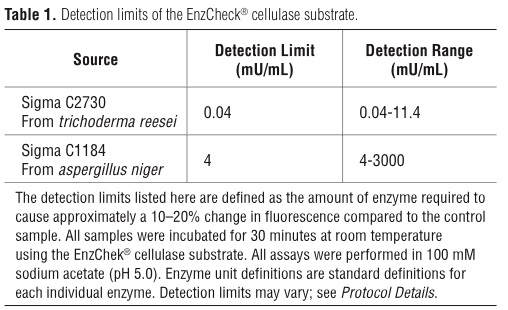IGEM:IMPERIAL/2009/M1/Assays/Cellulase/2005
Cellulase Assay 2005 - EnzCheck Invitrogen
Introduction
The EnzChek® fluorescence-based cellulase substrate was developed for simple and rapid quantitation of cellulase (EC 3.2.1.4). The assay can be completed in 30 minutes or less— simply mix the enzyme with the EnzChek® cellulase substrate working solution, incubate, and read the results. In contrast to other more complex, multistep assays, the EnzChek® cellulase substrate is perfect for use in a high-throughput environment. This fluorescence substrate is highly sensitive, with a detection limit as low as 40 µU/mL cellulase. It is also possible to use this substrate in a colorimetric assay, albeit with reduced sensitivity.
Materials
The EnzChek cellulase substrate is provided in a unit size of 1 mg. A suitable stock concentration for this substrate is 1 mM. This can be prepared by adding 1.86 mL of 50% DMSO directly to the vial of substrate. Sufficient material is supplied for ~186 assays, based on a 100 µL assay volume in a 96-well microplate format. The EnzChek® cellulase substrate can be adapted for use in cuvettes or 384-well microplates.
Storage
Upon receipt, store the substrate at ≤–20ºC, desiccated, and protected from light. Under these conditions the material should be stable for at least 2 years. Substrate solution may be kept at ≤–20ºC, however fluorescence background signal may increase over time.
Handling and disposal
We must caution that no data are available addressing the toxicity of the EnzChek® cellulase substrate. Treat the reagent with the same safety precautions as all other chemicals with unknown toxicity, and dispose of the dye in accordance with local regulations.
Protocol
During all steps, protect the EnzChek® cellulase substrate and any working solution(s) from light as much as possible.
1. Equilibrate the assay components to room temperature. Remove the EnzChek® cellulase substrate from storage and equilibrate to room temperature.
2. Prepare appropriate digestion buffers. We recommend using 100 mM sodium acetate for acidic cellulases. The substrate has optimal activity at pH 5.0. For 200 assays, 40 mL of digestion buffer will be sufficient: 20 mL for substrate preparation and enzyme titration and 20 mL for intermediate dilutions. Any unused digestion buffer should be stored at 2–6˚C and used only as long as it remains free of microbial growth.
3. Make a working solution of the EnzChek cellulase substrate. Dissolve the contents of one vial of cellulase substrate in 1.86 mL of 50% DMSO. Dilute the substrate 5 fold by transferring the entire contents of the vial to a disposable plastic container and adding 7.44 mL of digestion buffer (Molecular Probes scientists use 100 mM sodium acetate, pH 5.0) or other suitable cellulase buffer; see Protocol Details. This amount of substrate is enough to perform ~186 assays (50 µL per well in a 96-well microplate). For short-term storage (days), unused substrate solution may be placed at ≤–20ºC protected from light. Long-term storage is not recommended.
4. Prepare enzyme standard and sample dilutions. The Assay is optimized for 100μL. The protocol recommends making the dilutions in volumes of a least 500μL and to then transfer the 100μL into the well. Perform dilutions of the test enzyme and the standard enzyme in digestion buffer. Ensure that a sufficient volume of each dilution is prepared
so that each well contains 50 µL (account for duplicates or triplicates when making dilution series if they are to be used). Consult Table 1 for detection limits and ranges.
5. Load microplate. Distribute the cellulase dilution series (from step 4) in separate wells of a microplate (50 µL per well), Add 50 µL of digestion buffer to a separate well to serve as a buffer-only control. To each test and control well add 50 µL of EnzChek® cellulase substrate working solution (from step 3) and mix well. Duplicates or triplicates are recommended. Incubate for 30 minutes at room temperature, protected from light. Incubation times may vary; see Protocol Details.
6. Measure the fluorescence using a microplate reader. Excitation and emission maxima are 339 (shoulder at 360 nm) and 452 nm, respectively. Excitation/emission settings of 360/460 nm are optimal for this substrate.
7. Use a standard curve to determine cellulase activity. For the cellulase standards, plot amount vs. fluorescence, and fit a line to the data points. Sample standard curves are given in Figure 1.
Protocol considerations
Reagent dilutions
The digestion buffer described herein is recommended for detecting the activity of most cellulases complexes with activity optima from pH 4.5 to 6.0 using the EnzChek® cellulase substrate. Buffers other than this may be acceptable, although assay perfor- mance will be adversely affected at pH values below 4.5.
Sample volumes
The assay has been optimized for 100 µL total well volumes. We recommend preparing enzyme standard and sample dilutions in volumes of at least 0.5 mL, which are then distributed to indi- vidual wells of the microplate.
Assay times and temperatures
The assay temperature is “room temperature,” defined here as 20–25°C. Assay temperatures outside of this range have not been tested, but may be acceptable. The assay described here has been optimized for a 30 minute incubation period. Sensitivities may be increased by incubating longer. Conversely, if high sensitivity is not required, incubation times may be reduced. We recommend incu- bations of at least 5 minutes. The exact incubation period is not critical. However, it is important that all reactions being compared in the experiment are incubated for the same time.
Standard curves and detection limits
Detection limits may vary with instrumentation and enzyme source. Enzyme activity may vary depending on incubation buf- fers and temperature, as well as the storage conditions and number of freeze-thaw cycles to which the enzyme preparation has been subjected. Different dilution schemes of the same enzyme source may also cause variation in activity. Cellulase complexes may contain multiple classes of enzymes. For these reasons, we recom- mend preparing new standard curves on the same day samples are run, preferably on the same microplate. Use an appropriate enzyme standard of known specific activity that closely matches the cellulase activity being determined.

